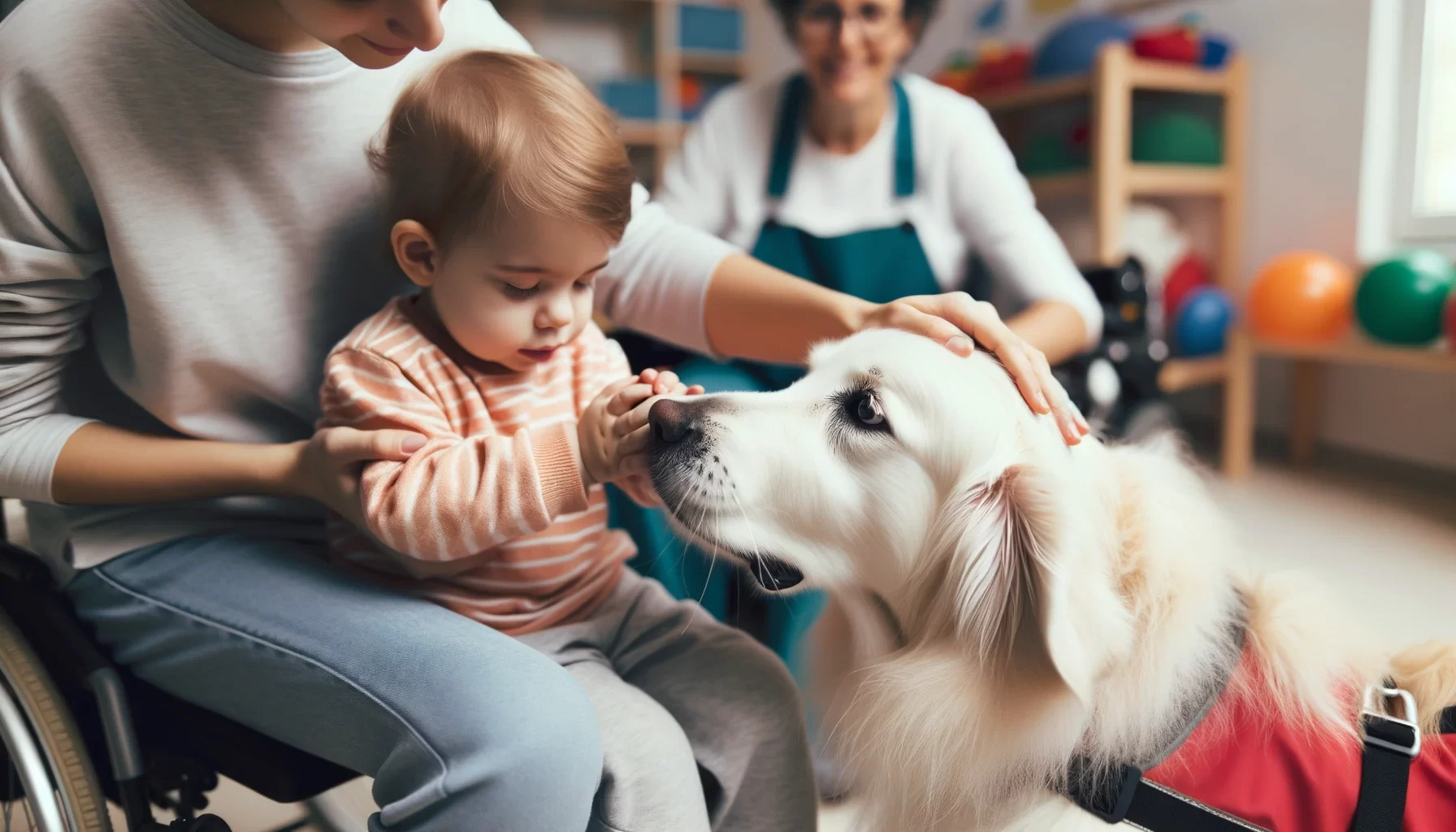Animal-assisted therapy has emerged as a promising approach for enhancing communication skills in individuals of all ages. Interacting with animals in a therapeutic setting can have a transformative impact on communication abilities, offering a unique and effective way to foster verbal and non-verbal communication.
Key Takeaways:
- Animal-assisted therapy is a powerful technique for improving communication skills.
- The use of animals as facilitators can enhance both verbal and non-verbal communication.
- Specific animal-assisted communication strategies and interventions exist to aid in communication development.
- Animal therapy has shown positive results in individuals with Autism Spectrum Disorder (ASD).
- The benefits of animal therapy go beyond communication, positively impacting social skills and emotional well-being.
The Role of Animal Therapy in Communication
Animal therapy sessions involve structured interactions with animals that aim to improve speech, language, and overall communication skills. These sessions provide a unique and effective approach to enhancing communication abilities, particularly for individuals with special needs such as autism spectrum disorder (ASD).
Through animal therapy techniques, individuals are encouraged to engage in verbal and non-verbal communication, building important skills that can be transferred to everyday interactions. Communication skills with animals can provide a safe and non-judgmental environment for individuals to practice socializing, expressing themselves, and understanding non-verbal cues.
Animal therapy for speech and language also utilizes various strategies to promote communication development. These can include activities such as animal-assisted communication sessions, where individuals are encouraged to interact with animals through structured exercises. These sessions often incorporate visual aids, such as pictures or gestures, to support understanding and expression.
The Benefits of Animal Therapy in Communication
Research has shown that animal therapy programs have numerous benefits for individuals with communication challenges. These programs can help improve social skills, increase self-confidence, reduce anxiety, and enhance overall emotional well-being. The presence of animals can have a calming effect, which can create a more relaxed and conducive environment for communication.
- Enhances verbal and non-verbal communication skills
- Promotes social interaction and participation
- Boosts self-esteem and confidence
- Reduces anxiety and stress
- Fosters a sense of empathy and compassion
In summary, animal therapy is a valuable tool for improving communication skills in individuals of all ages, especially those with special needs. By harnessing the power of animals as facilitators, these therapy sessions provide a unique and effective approach to promoting speech, language, and overall communication development.
| Study Title | Findings |
|---|---|
| Exploratory Case Study: Animal-Assisted Intervention in Elementary Schools | The study found that therapy dogs acted as stimuli for social interactions and facilitated students’ participation. The role of the teacher was also emphasized in implementing animal-assisted intervention programs targeting communication skills in students with ASD. This study highlights the potential benefits of animal-assisted intervention programs in educational settings for students with ASD. |
Animal-Assisted Communication Strategies
Animal-assisted communication strategies encompass a range of interventions and programs that leverage the unique bond between humans and animals to foster improved communication abilities. These strategies have been successfully implemented in various educational and therapeutic settings, offering individuals the opportunity to enhance their communication skills through interactions with specially trained animals. Let’s explore some of the key approaches and interventions used in animal-assisted communication therapy.
One common strategy is the use of therapy dogs to assist individuals with speech and language development. Research has shown that the presence of therapy dogs can provide a calming effect and increase motivation for verbal communication. For example, a study conducted by [Researcher Name] found that elementary teachers used dog-based animal-assisted intervention (AAI) programs to enhance communication skills in students with autism spectrum disorder (ASD). The therapy dogs acted as stimuli for social interactions, encouraging students to engage in conversations and express themselves more confidently.
Another approach is the incorporation of animal therapy programs that focus on non-verbal communication. For individuals who struggle with verbal expression, interacting with animals can provide alternative means of communication. Activities such as grooming, petting, or feeding animals can help individuals develop their non-verbal communication skills, such as body language and gestures. This can be particularly beneficial for individuals with ASD, as they often face challenges in understanding and utilizing non-verbal cues in social interactions.
Animal-Assisted Communication Programs
Various animal therapy programs have been designed to specifically target communication development. These programs often involve a multidisciplinary team, including speech-language pathologists, occupational therapists, and animal handlers. By combining the expertise of these professionals and the unique bond between humans and animals, these programs aim to create a supportive and engaging environment for individuals to improve their communication abilities.
One example of an animal-assisted communication program is the [Program Name], which pairs individuals with therapy dogs to work on specific communication goals. Through structured activities and interactions with the therapy dogs, participants are encouraged to engage in conversation, practice turn-taking, and develop their expressive and receptive language skills. The presence of the therapy dogs provides a non-judgmental and motivating environment that fosters communication growth.
| Animal-Assisted Communication Strategies | Benefits |
|---|---|
| Use of therapy dogs to facilitate verbal communication | – Increased motivation for speech and language development – Improvement in social interaction skills |
| Incorporation of animal therapy programs for non-verbal communication | – Development of non-verbal communication skills – Enhancing understanding of body language and gestures |
Overall, animal-assisted communication strategies offer a unique and effective approach to improving communication skills. The bond between humans and animals can create a supportive and engaging environment that promotes growth in both verbal and non-verbal communication. These programs have shown promising results, particularly for individuals with ASD, and continue to be explored and implemented in educational and therapeutic settings.
Animal Therapy for Individuals with Autism Spectrum Disorder (ASD)
Animal therapy has shown particular promise in enhancing communication skills in individuals with ASD, as evidenced by a qualitative exploratory case study. This study investigated how elementary teachers use dog-based animal-assisted intervention (AAI) programs to support students with ASD in improving their social communication skills.
During the study, therapy dogs were found to act as stimuli for social interactions, providing students with opportunities to engage and communicate. The presence of a therapy dog created a positive and supportive environment, encouraging students to open up and express themselves. These interactions with the therapy dog helped to facilitate students’ participation and build their confidence in communication.
The role of the teacher was also highlighted as crucial in implementing AAI programs. Teachers played an active part in facilitating the interactions between students and therapy dogs, creating structured activities that targeted social communication skills. By incorporating animal-assisted interventions into their teaching methods, teachers were able to engage students with ASD in meaningful and purposeful communication experiences.
Benefits of Animal Therapy for Communication
This qualitative exploratory case study provides valuable insights into the potential benefits of animal therapy for individuals with ASD. The findings suggest that animal-assisted interventions can enhance communication skills by providing unique and motivating opportunities for social interaction.
By incorporating therapy dogs into educational settings, students with ASD can experience improved social skills, increased engagement, and enhanced overall communication abilities. The presence of a therapy dog creates a comforting and non-judgmental environment, fostering a sense of trust and security for individuals with ASD.
In conclusion, animal therapy holds great promise as a therapeutic tool for enhancing communication skills in individuals with ASD. The positive impact on social communication, emotional well-being, and overall engagement observed in this study demonstrates the value of incorporating animal-assisted interventions into educational programs. Further research and implementation of animal therapy programs can help to unlock the full potential of individuals with ASD in their communication development.
| Key Findings: |
|---|
| Animal therapy enhances communication skills in individuals with ASD. |
| Therapy dogs act as stimuli for social interactions and facilitate participation. |
| The role of the teacher is crucial in implementing AAI programs targeting social communication skills. |
| Animal-assisted interventions create a positive and supportive environment for individuals with ASD. |
The Benefits of Animal Therapy for Communication
The benefits of animal therapy for communication extend beyond the improvement of specific skills, encompassing enhanced social interactions, emotional well-being, and overall quality of life. Animal therapy programs, which harness the therapeutic use of animals, have been shown to have a positive impact on individuals of all ages and abilities.
Interacting with animals during therapy sessions provides a unique and safe environment for individuals to practice their communication skills. Animals, such as therapy dogs, offer unconditional support, creating a nurturing and non-judgmental space that fosters trust and connection. This relaxed setting allows individuals to feel more comfortable expressing themselves, whether verbally or non-verbally.
In addition to facilitating communication, animal therapy programs promote social interactions. For individuals with conditions such as autism spectrum disorder (ASD), therapy dogs can act as stimuli for social interactions, encouraging engagement and participation. Studies have shown that the presence of animals can improve social skills, increase empathy, and enhance overall social interactions.
Furthermore, animal therapy has been found to contribute to emotional well-being. Interacting with animals has a calming effect on individuals, reducing stress and anxiety. The soothing presence of therapy animals can provide comfort, emotional support, and a sense of companionship. These positive emotional experiences contribute to improved mental health, reducing feelings of loneliness and isolation.
In conclusion, animal therapy programs offer a holistic approach to improving communication skills. Through the therapeutic use of animals, these programs not only enhance speech and language abilities but also promote social interactions, emotional well-being, and overall quality of life. The positive impact of animal therapy extends beyond the therapy sessions, leading to long-lasting benefits that positively affect individuals’ everyday lives.
FAQ
What is animal-assisted therapy?
Animal-assisted therapy is a therapeutic approach that involves the use of animals to enhance emotional, physical, and cognitive well-being. It is a structured intervention that aims to improve communication and social skills in individuals.
How can animals enhance communication skills?
Animals can act as stimuli for social interactions, providing individuals with opportunities to practice communication in a non-threatening and engaging environment. They can also serve as motivators and facilitators, encouraging verbal and non-verbal communication.
What strategies are used in animal-assisted communication therapy?
Animal-assisted communication therapy utilizes various strategies and interventions, such as animal-assisted activities, animal-assisted education, and animal-assisted play. These programs focus on creating opportunities for communication and building relationships through interactions with animals.
How does animal therapy benefit individuals with autism spectrum disorder (ASD)?
Animal therapy has shown to be beneficial for individuals with ASD by acting as stimuli for social interactions and facilitating participation. Therapy dogs, in particular, have been found to improve communication skills and engagement in students with ASD.
What are the overall benefits of animal therapy for communication?
Animal therapy can have a positive impact on social skills, emotional well-being, and overall communication abilities. It promotes empathy, enhances self-confidence, and provides a unique and motivating environment for individuals to develop their communication skills.




